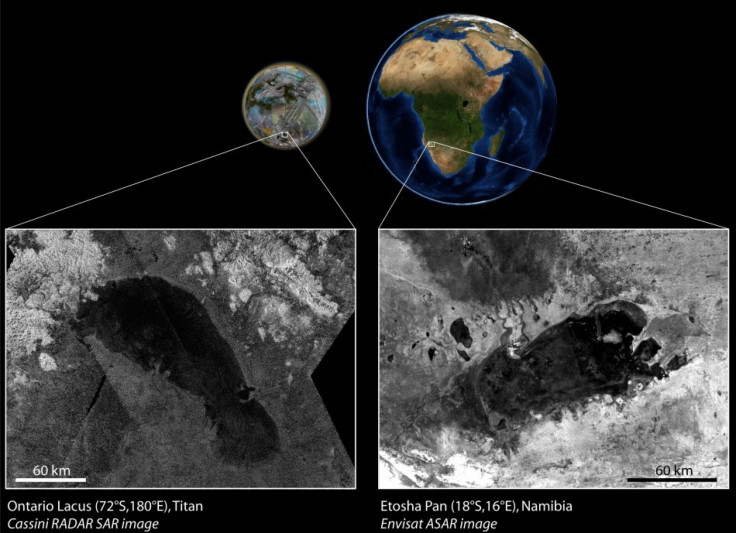African Lake Has Doppelganger On Saturn’s Moon

A lake on Titan, the largest Saturn moon, is similar to an African lake here on Earth, NASA and the European Space Agency concluded in a joint study. Named after Lake Ontario in Canada, Ontario Lacus on Titan shares similarities with Etosha pan, an ephemeral lake in northern Namibia that seasonally dries out.
Astronomers originally figured Ontario Lacus was permanently filled with thin layer liquid methane and other elemental compounds since the discovery by Cassini spacecraft in 2009. However, a recent reexamination of the images from Ontario Lacus indicates that the lake regularly dries up, much like Etosha pan.
Finding familiar geological features on alien worlds like Titan allows us to test the theories explaining their formation, Nicolas Altobelli, a project scientist for ESA, said in a statement. These results emphasize the importance of comparative planetology in modern planetary sciences.
The journal Icarus published the study on Thursday.
Researchers found sediment marks in parts of Ontario Lacus, suggestive that methane levels are in flux. Evidence suggested that parts of the lake are dry, based on channels astronomers found carved into the lakebed. Ontario Lacus likely fills with methane before partially drying out as part of a cycle, according to the study authors.
Though mostly dry, Etosha pan accumulates a layer of water after a heavy rain. The water mixes with minerals on the lakebed and leaves deposits when it evaporates, similar to the deposits seen on the Titanic lake, researchers found.
Similarities between Earth and other celestial bodies give researchers an opportunity to better understand how they form and creates a better understand not only of the foreign body but of Earth as well, researchers said.
Titan is the only other known body in the solar system with liquid. While Earth has the water cycle, Titan cycles hydrogen, carbon and nitrogen. The cycle, coupled with other ongoing organic processes, means that Titan could support life, experts theorize.
Titan's bedrock comprises water ice covered by various organic compounds, Roger Clark, a Cassini team scientist based at the U.S. Geological Survey, said in a 2010 study. The ice remains covered despite constant rain that should wash it away, indicating that the world is active.
Titan's atmospheric chemistry is cranking out organic compounds that rain down on the surface so fast that even as streams of liquid methane and ethane at the surface wash the organics off, the ice gets quickly covered again, Clark said in a 2010 statement. All that implies Titan is a dynamic place where organic chemistry is happening now.
Titan is much too cold for water -- temperatures are usually around -290 degrees Fahrenheit (-178 degrees Celsius), Clark said. However, scientists postulate that methane-based organisms, as opposed to the carbon-based organisms on Earth, could exist on other worlds. Although researchers have not discovered any methane-based organisms, there are microbes on Earth that thrive on methane, giving credence to the idea.
Cassini will orbit Saturn until 2017, at which point it will crash into the planet.
© Copyright IBTimes 2025. All rights reserved.





















